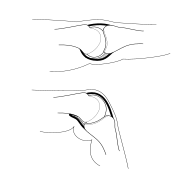Palmar plate
| Palmar plate | |
|---|---|

MCP joint in extension and in flexion, palmar plate in grey
|
|
| Details | |
| Latin | ligamenta palmaria |
| Dorlands /Elsevier |
12492745 |
|
Anatomical terminology
[]
|
|
In the human hand, palmar or volar plates (also referred to as palmar or volar ligaments) are found in the metacarpophalangeal (MCP) and interphalangeal (IP) joints where they reinforce the joint capsules, enhance joint stability, and limit hyperextension. The plates of the MCP and IP joints are structurally and functionally similar, except that in the MCP joints they are interconnected by a deep transverse ligament. In the MCP joints, they also indirectly provide stability to the longitudinal palmar arches of the hand. The volar plate of the thumb MCP joint has a transverse longitudinal rectangular shape, shorter than those in the fingers.
This fibrocartilaginous structure is attached to the base of the proximal phalanx distal to the joint. From there, it forms a palmar continuation of the articular surface of the phalanx bone and its inner surface thus adds to the articular surface during extension.
In its proximal end, the volar plate becomes membranous and blends with the volar capsule which is attached to the head of the metacarpal bone. During flexion, the plate glides proximally down the volar surface of the metacarpal head. Its flexible attachment to the phalanx bone not only prevents it from restricting joint movements, but also prevents the long flexor tendons from being pinched in the joint. Flexion of the proximal phalanx is facilitated by the shape of the proximal edge, known as the volar recess, but this diaphanous end of the volar plate is also the part of the metacarpophalangeal joint that is most susceptible to injury during dislocations.
Due to its fibrocartilaginous composition, the plate is thus able to (1) resist tensile stresses while (2) restricting hyperextension and compression and (3) protecting the volar articular surface.
The palmar plate moves in three phases during joint flexion. First, it slides back toward the hand. Next, it is lifted away from the proximal phalanx by the A3 pulley. Last, a lip on the middle phalanx rolls into a recess on the plate. If the A3 pulley is not intact, the normal three phases of motion do not occur and instead the plate crumples.
...
Wikipedia
